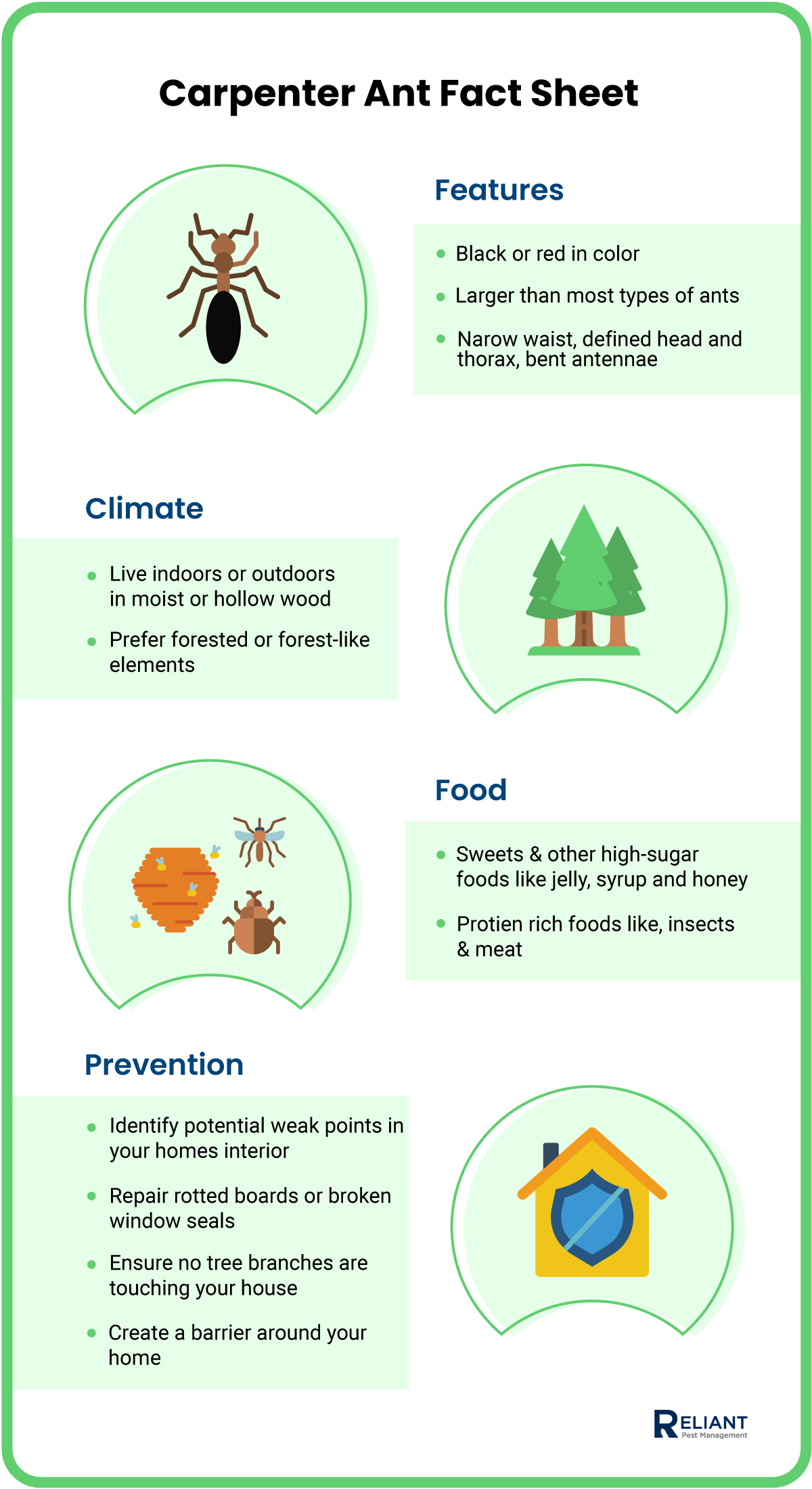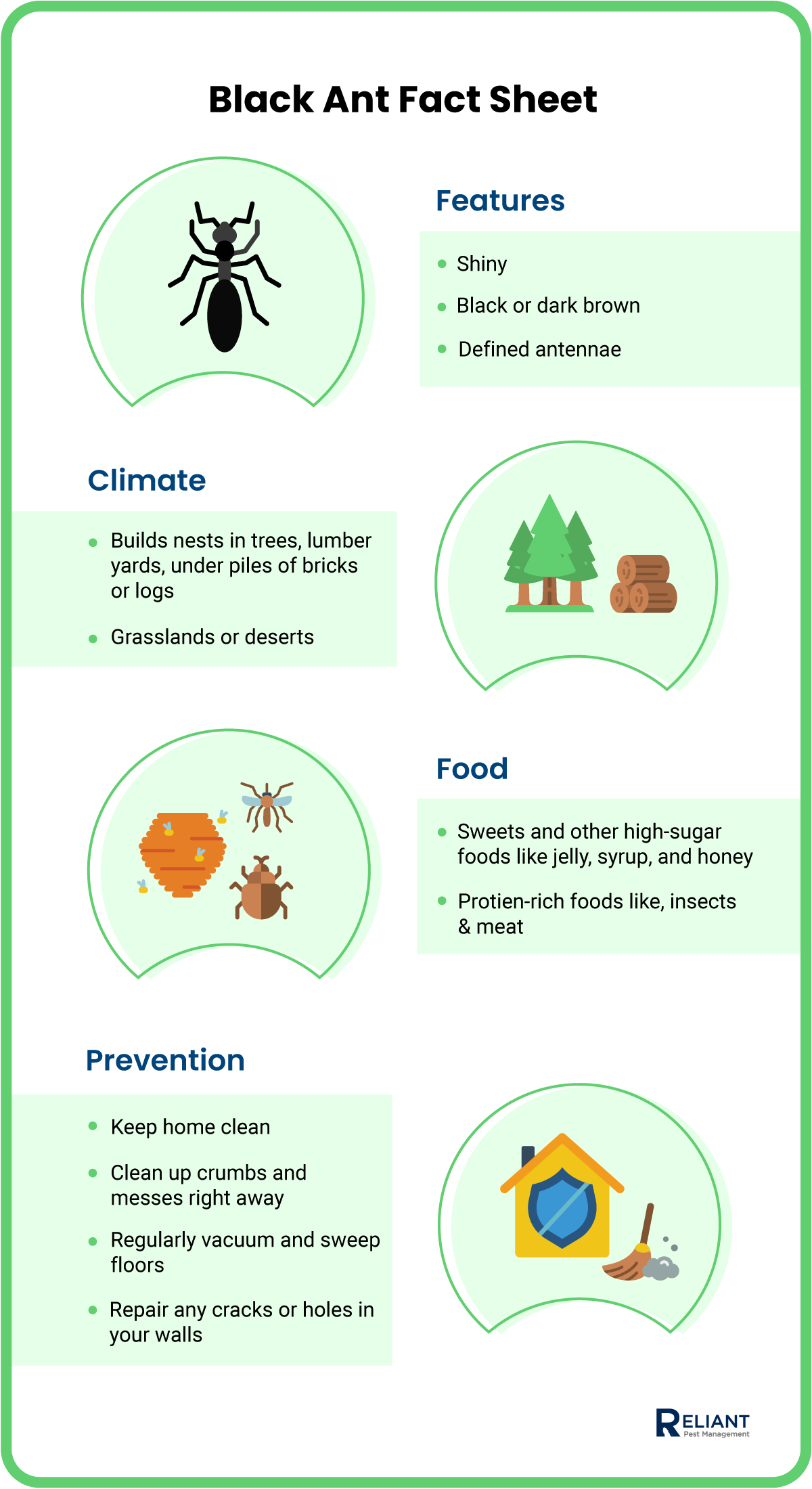Do you know the difference between carpenter ants and black ants? Many people don’t because they both look very similar.
In this blog post, we’ll discuss the differences between these two types of ants so that you can identify them properly if you ever see them.
We’ll also talk about what kind of damage these ants can do, and how to get rid of them if they become a problem.
Key Takeaways
- One major difference between big black ants and carpenter ants is in the types of problems they pose – carpenter ants are similar to termites in that these pests can cause major structural damage.
- While carpenter ants are common pests in wooden structures, little black ants can live just about anywhere.
- There are several steps that work well to get rid of both ant species such as cleaning up plant matter and keeping your house clean.
Facts About Ants
Did you know that ants are some of the strongest creatures in the world relative to their size? They can carry upwards of 50 times their own body weight, which is pretty impressive! Ants also don’t have lungs or ears. Instead, they rely on tiny holes all over their bodies, called spiracles, to breathe. And since they don’t have ears, they communicate by vibrating their bodies.
Ants are highly social insects, living in colonies that can number in the millions. Each colony has three different types of ants: the Queen, the Workers, and the Soldiers.
The Queen is the only ant in the colony that can lay eggs, and she can live for up to 30 years. Workers are sterile females that take care of the Queen and the eggs, as well as gathering food and building the nest. Soldiers are sterile males whose role is to protect the colony from invaders.
In addition to communicating via vibrations, ants also have an amazing ability to communicate with one another using chemical signals called pheromones. They also have a very strong sense of smell, which they use to find food and distinguish between friend and foe.
What Are Carpenter Ants?

Carpenter ants are a type of ant that is well known in the United States for its wood-damaging habits. Although carpenter ants can be a nuisance, they are not typically harmful to humans. However, carpenter ants can cause significant damage to buildings by hollowing out the wood that supports them, including in wall voids, around door frames, and more. For this reason, it is important to control carpenter ant populations around homes and other structures.
Features
These ants are black or red and black in color and are larger than most other types of ants. Carpenter ants are usually black or red in color, and they can range in size from a few millimeters to over a centimeter long.
These ants have an abdomen with a narrow waist, a defined head and thorax, and bent antennae.
Climate
Carpenter ants are one of the most common types of ants found in North America. They get their name from their habit of building their nests in wood, which they hollow out by chewing through the wood with their strong mandibles. They will live indoors or outdoors, in moist or hollow wood, and prefer forested or forest-like elements (such as tree stumps).
Foods
Black carpenter ants are attracted to moisture, so they are often found near sources of water such as leaky pipes or damp wood. They also prefer to nest in hollow wood, so they often tunnel into lumber or other wood products.
Carpenter ants are generally more active at night, and they are able to travel long distances in search of food. When they invade homes, they typically go after sweets and other high-sugar foods like jelly, syrup, and honey. However, carpenter ants will also eat protein-rich foods like insects and meat. They’ll even eat pet food!
Prevention
Carpenter ants get their name from their nesting habits; they build their nests by tunneling into wood, which can cause damage to homes and other structures.
Carpenter ants do not eat wood; instead, they remove it to create space for their nests. These ants are often found in damp or rotten wood, so they can be a sign of water damage in your home.
The first step is to identify potential weak points in your home’s exterior. Carpenter ants are attracted to damp, decayed wood, so it’s important to repair any rotted boards or broken window seals. You should also make sure that there are no tree branches touching your house, as these can provide a direct path for ants to enter.
Once you’ve sealed up potential entry points, the next step is to create a barrier around your home. There are a number of ant repellents on the market that can help to keep carpenter ants at bay. Some of the most effective include diatomaceous earth, boric acid, and citrus-based sprays. You can also try placing mint leaves or lemon peels near areas where you’ve seen ants – they hate the smell!
If you see carpenter ants in your home, you should have a professional inspect your property for water damage and repair any affected areas. A severe carpenter ant problem can be tough to remedy on your own, especially if they’ve built extensive galleries in your walls.
What Are Black Ants?

Black ants are one of the most common species of ant found in North America. (Believe it or not, there are more than 10,000 known species of ants in the world. That’s a lot of different kinds of ants!
Black ants live in colonies that can number in the thousands, and they use their strong mandibles to build their nests out of dirt and other materials. These nests can sometimes be found in your yard or garden, and they can be a nuisance if they start to invade your home.
However, large black ants are not considered to be harmful to humans, and they actually play an important role in the ecosystem by preying on other insects.
Features
The common black ant is small, measuring just a few millimeters in length, and it typically is a shiny black or dark brown in color. They have six legs and a set of defined antennae.
Climate
Black ants are common in wooded habitats, where they build their nests in trees, among lumber yards, and under piles of bricks or logs. These insects are very adaptable and can also be found in grasslands and deserts.
The black ant is a social insect that lives in colonies. A large colony can contain thousands of ants and are often found near sources of food. The black ant is an important part of the ecosystem because it helps to recycle nutrients and aerate the soil. Black ants are also a food source for many animals, including birds, reptiles, and mammals.
Foods
These small insects are attracted to a variety of food sources, including protein and sugar. Meat, pet food, jelly, syrup, and honey can all attract black ants into your home.
Prevention
One of the best ways to prevent black ants is to keep your home clean. Black ants are attracted to food and other spills, so make sure to wipe up any crumbs or messes right away. You should also regularly vacuum and sweep your floors, as this will remove any potential food sources that ants might be attracted to.
In addition, consider using natural repellents like salt, lemon juice, vinegar, or cinnamon around your home. These substances will help to keep ants away without the use of harmful chemicals. Finally, make sure to repair any cracks or holes in your walls, as this will give ants fewer places to enter your home. By following these simple tips, you can help to keep black ants at bay.
What’s The Difference Between Carpenter Ants And Black Ants?
Both black ants and carpenter ants can be a nuisance, but there are some key differences between the two species.
For one thing, carpenter ants are much larger, measuring up to half an inch in length. They are also more likely to invade homes and other structures, as they are attracted to damp wood. In contrast, black ants are generally content to live outdoors and are not typically problematic for homeowners.
Another difference is that carpenter ants have flat abdomens, while black ants have rounded abdomens.
Finally, carpenter ants are usually solid black, while black ants can vary in coloration, including shades of brown and red. While both types of ant can be a nuisance, understanding the differences between them can help you choose the most effective method of control.
| Size: Carpenter ants measure bigger at around ½” long. Black ants are smaller at around ¼” long. | Color: Carpenter ants can vary in colors including black, brown, or red. Black ants are shiny black. |
| Shape: Carpenter ants are almost perfectly round. Black ants are much more unevenly shaped. | Wings: Carpenter ants have 2 sets of wings. Black ants have 1 set of wings if any. |
Conclusion
While carpenter ants and black ants may look alike to the untrained eye, some key differences will help you tell them apart.
Understanding these distinctions can help you take steps to address an infestation quickly and effectively. Carpenter ants prefer moist wood, while black ants are drawn to sugary foods.
Additionally, carpenter ants have a single node in their antennae, while black ants have three nodes.
If you’re seeing large numbers of either type of these crazy ants around your home or business, it’s important to take action right away. Use these tips to guide you toward the right decision!